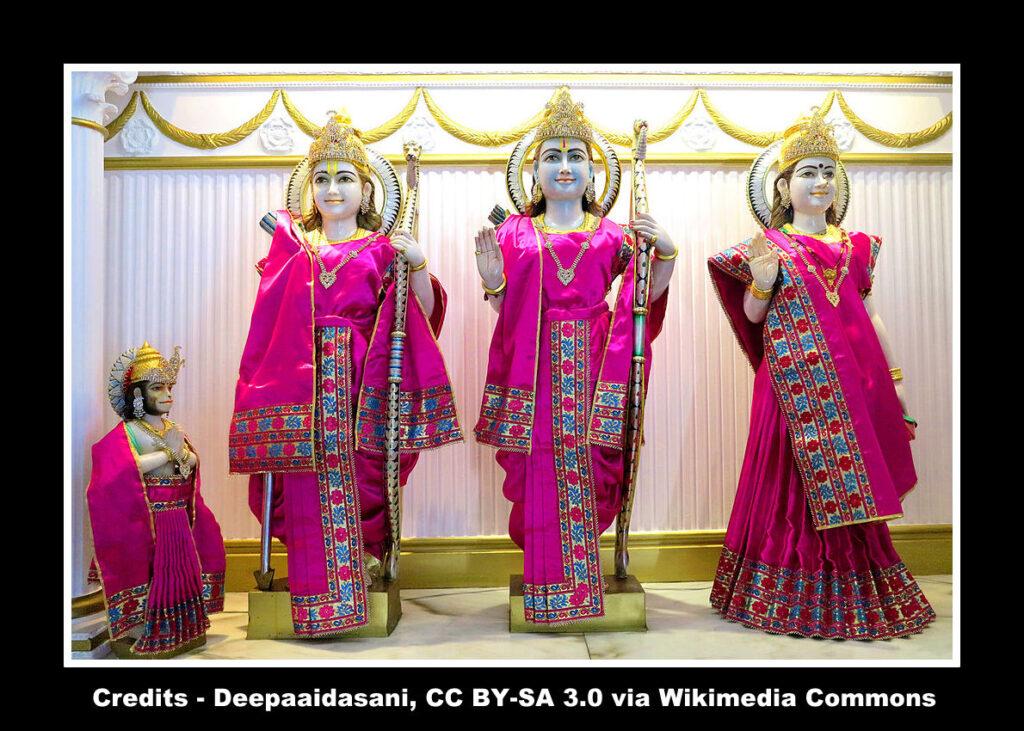
On the ninth day of the bright fortnight of the month of Chaitra in Treta Yuga, Lord Ramachandra was born in Ayodhya, a city in northern India. This day has since been celebrated by the entire world as Ram Navami. The ninth canto of Bhagavata Purana states that Lord Ramachandra was born in the dynasty of Maharaja Khatvanga. The son of Maharaja Khatvanga was Dirghabahu and his son was Raghu. Aja was the son of Raghu and the son of Aja was Dasaratha. Lord Ramachandra was the son of Dasaratha and mother Kaushalya. King Dasarath had three wives – Kaushalya, Kaikeyi, and Sumitra. Ramachandra was none other than Vishnu, the Supreme Lord and He had descended into this world along with His full quadruple expansion – as Lord Rama, and brothers Lakshmana, Bharata, and Shatrughna. Bharata was the son of Kaikeyi while Lakshmana and Shatrughna were the sons of Sumitra. Of all the brothers, Ramachandra was especially glorious. His body possessed a hue of celestial emerald. He was devoted to His father’s service. He quickly mastered the science of archery, horseback, and elephant riding, as well as various methods of driving a chariot. Lakshmana, since his childhood, was very attached to his elder brother Rama and pleased Him in every way. This article delves into the captivating tale of how Rama weds Sita, his eternal companion. It narrates the journey of Rama and Lakshmana as they accompanied the revered sage Visvamitra to Mithila, where Rama’s remarkable prowess was showcased, ultimately leading to his marriage with Sita.
Lord Rama travels with sage Visvamitra to kill Rakshasas
One day sage Visvamitra arrived at King Dasaratha’s palace where he was warmly greeted. The sage described to the King how two rakshasas Maricha and Subahu repeatedly impeded the execution of his Yajnas (sacrifices). Every time his sacrifice neared completion, the demons ruined it by dropping flesh and blood into the sacred sacrificial arena. Hence he requested King Dasaratha to send Ramachandra with him for ten days so that the young prince can vanquish the demons who impeded the peaceful life of the sages. The King was shocked to hear the sage’s request. Although young Rama was a brave and an expert warrior, He had no previous experience of fighting on the battlefield. On the other hand, the Rakshasas knew every kind of sorcery. They could contend even with the Gods. Seeing the King anxious, sage Vivamitra reassured him that no harm would befall the prince and requested the king to grant his request. Actually, sage Visvamitra was aware that Rama was none other than the supreme Lord. He also understood that the annihilation of demons was one of the reasons why the Lord had incarnated. Hence the sage only acted as an instrument of the Lord’s will. King Dasaratha was mortified and even fell unconscious fearing for his son’s life. Finally, on the advice of sage Vasistha, the King relented. As Lakshmana would not leave his brother alone, both Rama and Lakshmana sought their leave and departed with sage Visvamitra.
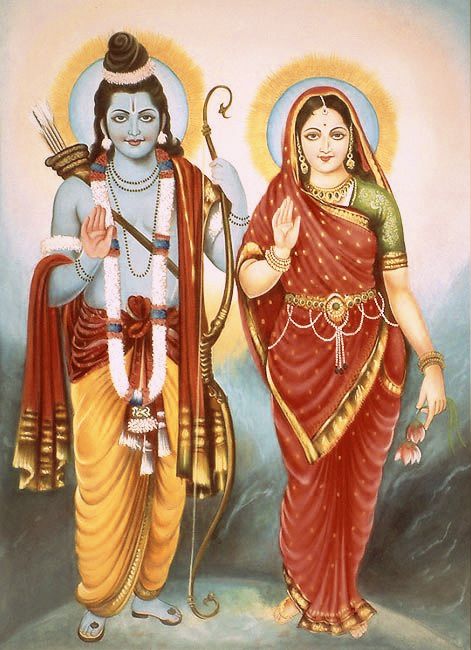
Rama and Lakshmana, along with Sage Visvamitra, traveled to a desolate region that was infested with demons and beasts. Visvamitra told them that the region was once home to two beautiful kingdoms, but it had been ravaged by a Yaksha named Tataka. Tataka was a powerful demon who could assume any form she desired, and she killed humans indiscriminately.
Rama was reluctant to fight Tataka, as she was a woman, but Visvamitra convinced him that it was necessary to protect the innocent. A violent battle ensued, in which Tataka continuously changed her form to try to defeat Rama and Lakshmana. However, Rama’s skills as an archer were superior, and he eventually killed Tataka with an arrow.
The next day, Visvamitra led Rama and Lakshmana to a different place where he taught them the knowledge of celestial weapons. On the sixth night, the sages began a sacrifice, and the two rakshasas Maricha and Subahu, along with other demons, attacked them. Rama and Lakshmana fought bravely, and Rama eventually killed Maricha and Subahu with his celestial weapons. The sages were delighted, and they were able to complete their sacrifice peacefully.
Rama’s Unprecedented Feat: Stringing Shiva’s Bow and Winning Sita’s Hand
Visvamitra informed the two princes, Rama and Laksman, about a sacrifice to be held by King Janaka of Mithila, and they set out for Mithila with him. Upon their arrival in Mithila, they were greeted by a scene of grandeur and festivity. The city was bustling with joy, adorned with temples, market stalls selling a variety of goods, and welcoming residents. As they journeyed, they were met with respect and curiosity from the people who had heard of their arrival.
The king’s ministers, aware of their visit, came to meet them and escorted them to Janaka’s palace. The anticipation in the air was palpable as the crowd speculated about the purpose of their visit. Some wondered if these were the sons of Emperor Dasaratha, and the possibility of them attempting to string the king’s great bow intrigued everyone. Janaka himself came out to welcome them with great reverence and hospitality.
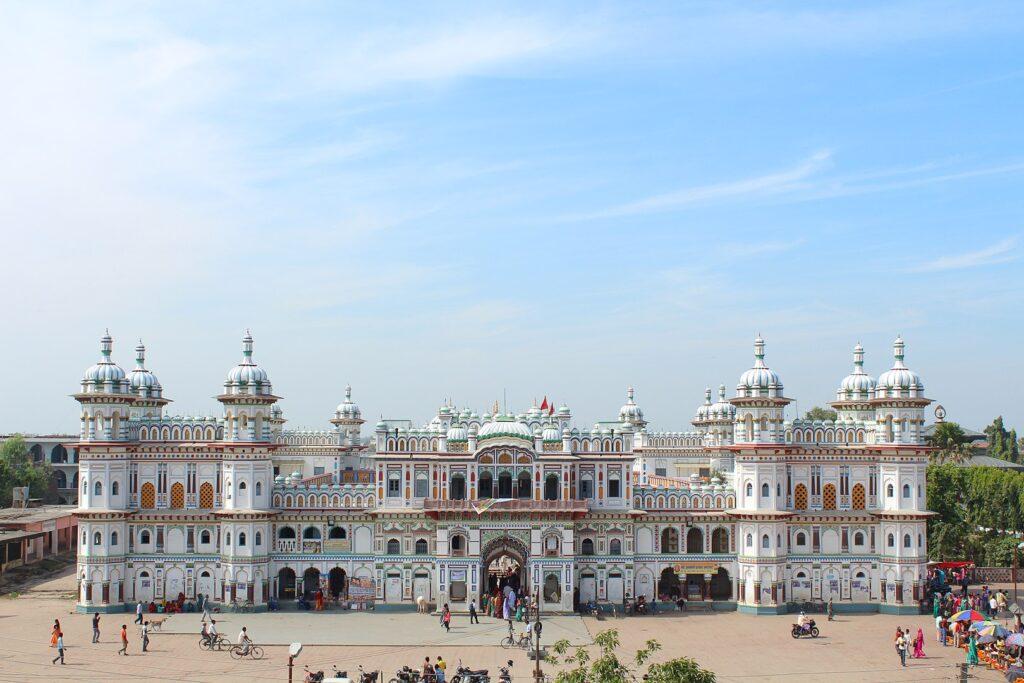
After completing the initial ceremonies, a lavish meal was served to Visvamitra and the two princes. They sat on silk rugs on the floor, with tables made of ivory holding dishes of gold and silver, enjoying a variety of delicious foods. Once the meal was savored, Janaka expressed his gratitude for Visvamitra’s presence in his home and inquired about the two young princes. He patiently waited until they were refreshed and rested before asking about their purpose.
Visvamitra then shared the story of the princes, explaining how they had defeated the Rakshasas in the forest and had come to Mithila with the intention of witnessing the famous bow. Janaka was thrilled to learn that they were princes from Ayodhya, and he hoped earnestly that Rama would successfully pass the test of the bow.
The following day, Janaka, full of respect, approached Visvamitra and asked how he could be of service to the virtuous sage, acknowledging the honor of his presence.
Hearing these words of humility from the gentle and virtuous king, Visvamitra requested to be shown the bow. Janaka agreed, but before leading them to the bow, he provided its history.
Janaka explained the history of the celestial bow, which had originally belonged to Lord Shiva. Shiva, displeased with other gods’ refusal to share offerings from sages, had threatened to use the bow to sever their heads. Eventually, the gods appeased Shiva, and he gave them the bow. Over time, it came into the possession of Janaka’s ancestor, Devarata, as a reward for helping in a battle against demons. The bow had been treasured within the royal family ever since.
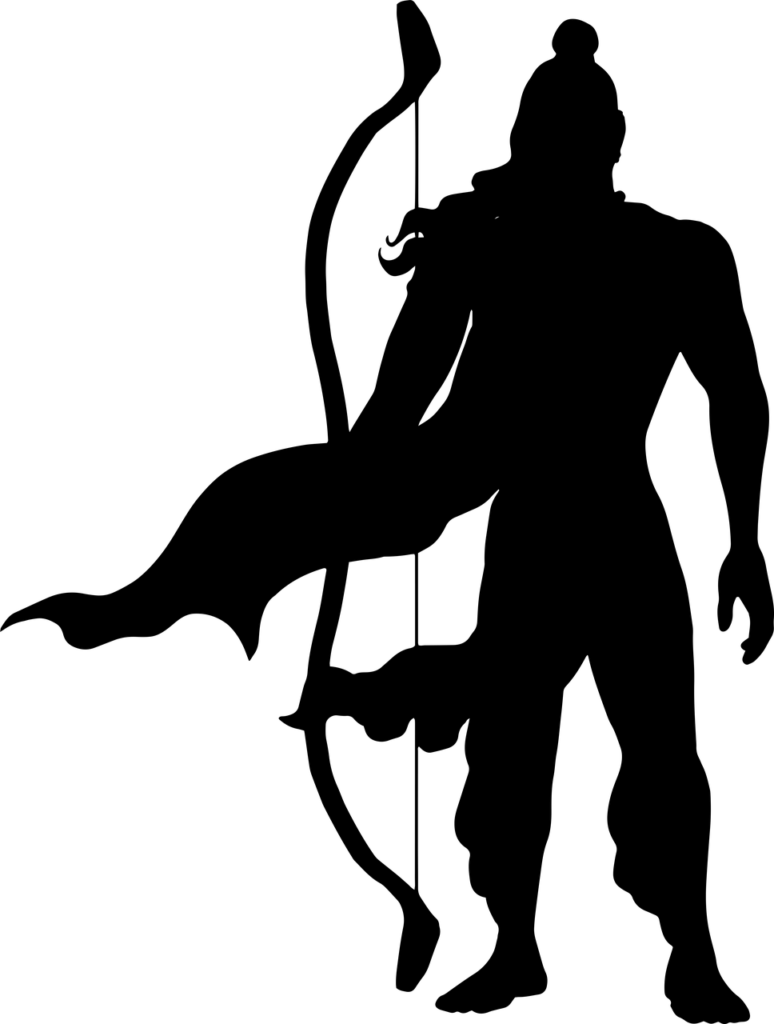
Janaka went on to describe Sita’s divine birth, recounting how she had emerged from the Earth during a sacrifice and had been raised as his own daughter. He expressed his decision to bestow Sita’s hand in marriage upon the one who could string Shiva’s bow.
Numerous mighty kings had attempted to bend the bow arrogantly, believing it to be an easy task, but they had all failed miserably. Some couldn’t even lift it. Frustrated by their failures, these kings had laid siege to Mithila for a year until Janaka, in his desperation, had prayed to the gods for help. In response, the gods had sent a celestial army that swiftly dispersed the belligerent kings in all directions. Thus, the unstrung bow had remained in Mithila, awaiting a truly powerful king.
Janaka turned to Rama, expressing his confidence that Rama would succeed where others had failed. He admired Rama’s beauty, strength, and noble character and eagerly looked forward to Rama’s attempt to string the bow. He invited Rama to behold the magnificent celestial bow, emphasizing its divine origin and the fact that not even gods, demons, or other celestial beings could string it, let alone an ordinary man.
Janaka ordered the chest to be opened, revealing the radiant bow. It cast a golden glow in all directions, crafted from pure horn and adorned with gold and silver depictions of divine tales. The bow bore hundreds of golden bells and ornaments, studded with diamonds and other precious gems.
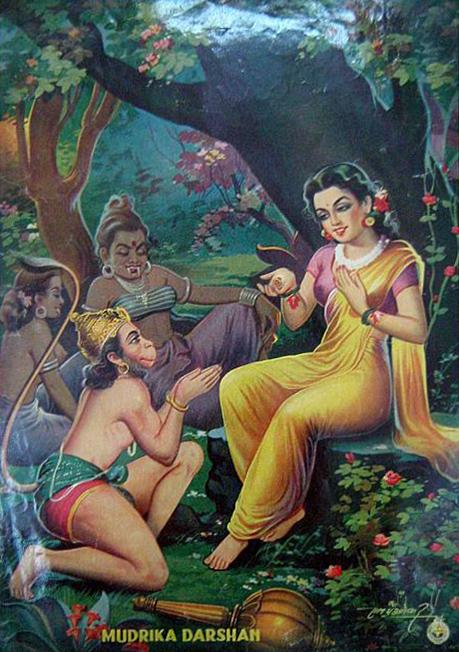
Upon seeing the bow, the two princes were filled with awe. Rama bowed respectfully before it, then circled it slowly, his eyes conveying his appreciation to Visvamitra, who nodded in response. Understanding Visvamitra’s signal, Rama positioned Himself at the center of the bow and turned to Janaka. “I wish to attempt your test. I shall lift this divine bow to assess its weight and strength.”
As they watched in hushed anticipation, Rama laid His hand upon the bow. A profound silence enveloped the hall. Janaka held his breath, Visvamitra’s knowing smile barely noticeable. From a balcony in the hall, Sita observed Rama, feeling a natural attraction to the prince. Until this moment, She had been indifferent to Her suitors, even though the most powerful kings from across the world had sought Her hand. To the gentle Sita, they had all appeared arrogant and overly proud. Sita was profoundly devoted to her faith. Throughout her entire life, she had fervently prayed for Vishnu to become her husband. As she watched Rama confidently approach the bow, her love for the Lord surged within her. Could this be Vishnu himself? Immersed in her affectionate feelings, Sita was filled with anxiety. Would Rama be able to string the bow and become her husband? She clutched the matrimonial garland with trembling hands.
Suddenly, Rama grasped the bow at its midpoint and raised it high above his head. The hall filled with gasps of astonishment; it seemed inconceivable. Rama casually tested the bow’s weight by giving it a slight toss. Then, he positioned one end of the colossal bow on the ground and effortlessly strung it. He pulled the string, bending the bow into a graceful semi-circle. In a thunderous moment, the bow snapped, and the sound echoed like a thunderclap throughout the hall. The earth itself quivered as if caught in an earthquake. Everyone present was left stunned and temporarily speechless.
Janaka was deeply moved and awed by Rama’s extraordinary strength and achievement in effortlessly handling the celestial bow. He was convinced of Rama’s divine nature, realizing that Rama was unlike any other mortal king. No one had even been able to move the bow, let alone string it, until Rama had done so effortlessly. Tears welled up in Janaka’s eyes as he grasped the significance of Rama’s divine power.
With a heart full of joy and conviction, Janaka contemplated the honor and renown that Sita’s marriage to Rama would bring to his family. His gaze then shifted to Sita, who stood on the balcony, radiating delight and anticipation, surrounded by her attendants. She eagerly awaited her father’s signal to descend and unite with Rama.
Janaka, with unwavering determination, turned his attention back to Rama, expressing his wholehearted commitment to fulfill his vow. He emphasized that despite Sita’s immense value to him, he was resolute in offering her hand in marriage to Rama, acknowledging Rama’s exceptional qualities and divine nature.
Sita descended from the balcony, holding a garland of golden flowers in her hands. She stood beside her father, adorned in a deep maroon silk sari with a pearl necklace gleaming on her bosom. As she moved, her golden anklets tinkled melodiously, and her diamond earrings swayed gently. With a shy and gentle smile, she cast her eyes downward and then, lifting them slightly, gazed at Rama, who met her gaze. Both their hearts surged with love, forging their union in that very moment. Following her father’s signal, Sita approached Rama and placed the garland around his neck, symbolizing her acceptance of him as her husband. Blushing ever so slightly, she lowered her eyes and walked back slowly to her father, who felt his heart might burst with happiness.
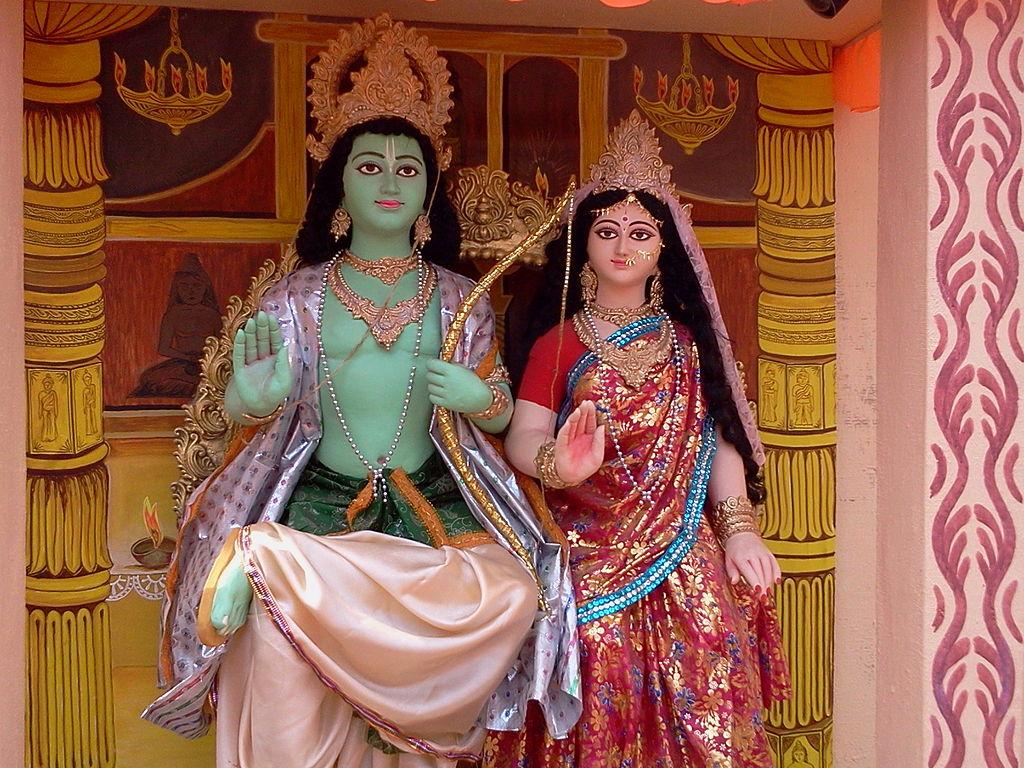
The king was eager to proceed with the marriage ceremony without delay. He sought Visvamitra’s approval, and once the sage agreed, the king swiftly dispatched messengers to Ayodhya to inform Dasaratha.
Wedding of Rama and Sita
Messengers from Janaka arrived in Ayodhya after a three-day journey and were welcomed into Emperor Dasaratha’s presence. The ministers recounted the events in Mithila, bringing joy to the emperor as he learned of Rama and Laksman’s safety and their success in vanquishing demons. Dasaratha saw this as a providential union, especially since he had been contemplating his sons’ marriages when Visvamitra arrived.
Following counsel from his advisors, Dasaratha decided to leave for Mithila the next day. With his ministers and priests, he embarked on the journey, reaching Mithila after five days. Janaka warmly received him, and they discussed the upcoming wedding, including the divine birth of Sita and a prophetic revelation.
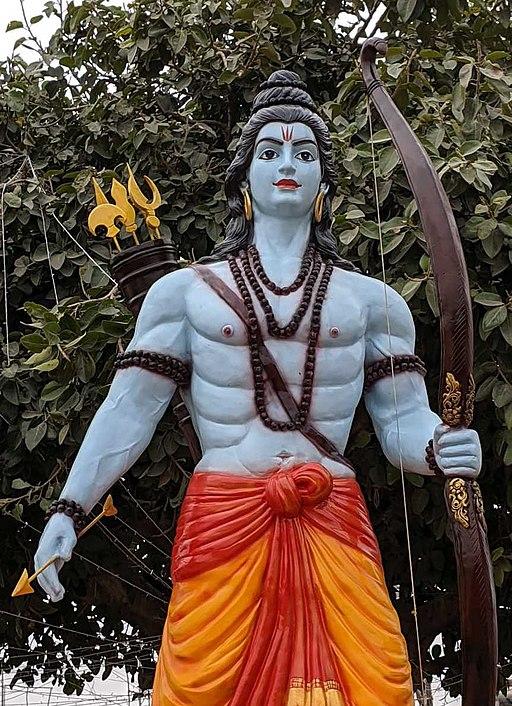
“Once, the celestial seer Narada informed me that Sita is Vishnu’s eternal consort, destined to become His wife in this world,” Janaka revealed. “To ensure that only Vishnu Himself could pass the test, I devised a challenging trial. Your son, Rama, has successfully completed it, making Him the rightful husband of Sita.”
Dasaratha, despite once again being astonished by Rama’s divinity, was deeply rooted in his love for Rama, which overshadowed any thoughts of Rama’s divine nature. He wholeheartedly approved of the marriage between Rama and Sita and emphasized the importance of conducting all the necessary rituals and ceremonies with precision, believing that the success of a gift depended on the manner in which it was presented.
Following their discussion, Janaka’s ministers received instructions, and Janaka and Dasaratha sat together in the grand palace hall. They listened as Vasistha recited Rama’s lineage, tracing it back to the sun-god. Janaka, in turn, recited the lineage of Sita, which began with Brahma.
Visvamitra then proposed an arrangement for the marriages, suggesting that Sita’s sister, Urmila, wed Rama’s brother, Laksman, and Janaka’s brother, Kushadhvaja, allow his two daughters to marry Bharata and Shatrughna. This plan was met with Janaka’s enthusiastic approval. He showed his respect to Visvamitra by prostrating before him and expressed his readiness to comply with the sage’s guidance. The auspicious wedding date was set for the following day, aligned with favorable celestial conditions.
As the two kings continued their conversation, the sun began to set, and Janaka took his leave from Dasaratha. They were accompanied by their ministers and a hundred warriors, while thousands of golden oil lamps illuminated the hall, and the Brahmins departed, chanting auspicious Vedic hymns.
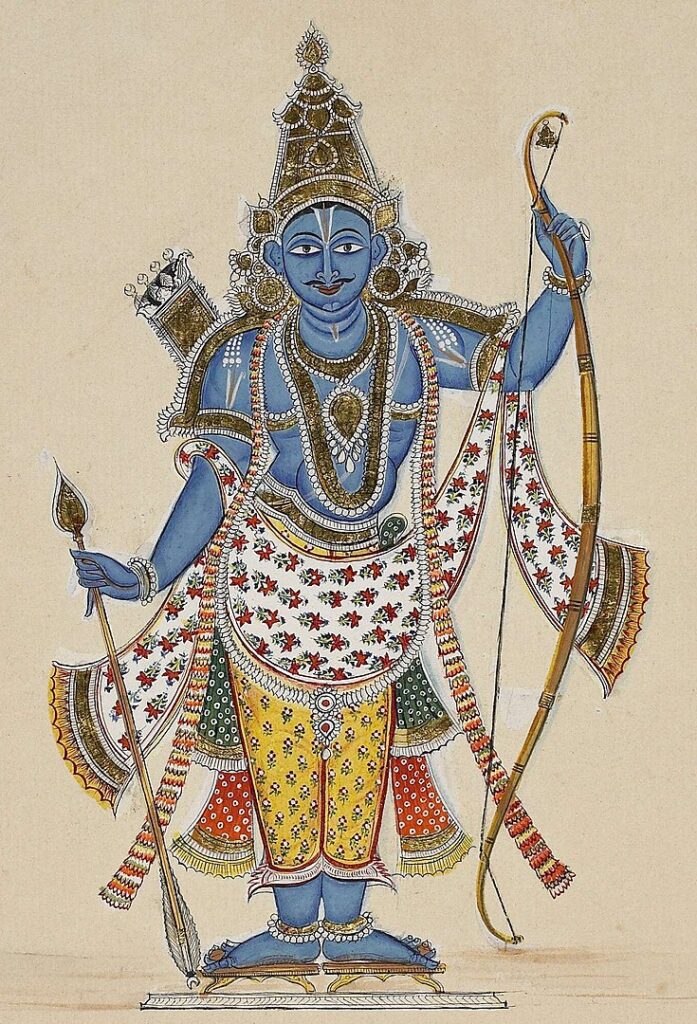
The next morning, Dasaratha initiated the day with a ritual for good fortune. He offered a hundred thousand cows on behalf of each of his four sons to the Brahmin priests and distributed gold and gems to the sages who had gathered in Mithila for the wedding. The four princes, dressed in silk robes and jeweled ornaments, stood beside their radiant father.
A magnificent pavilion was erected for the grand ceremony, adorned with gem-studded pillars and fragrant flower garlands. The air was filled with the scent of black aloe incense, and rows of golden seats surrounded the sacred area. Kings, princes, and ministers from distant places eagerly attended the auspicious occasion. Chants of “All glories to Rama and Sita!” filled the pavilion, and elderly Brahmins recited Vedic hymns while musical instruments played and singers praised the divine couple, creating a celestial atmosphere.
Dasaratha and his sons, seated near the sacred fire tended by Vasistha, watched as Sita and the other three princesses entered. The princes were captivated by the beauty of their future brides, who were adorned in splendid silk garments, jewels, and gold ornaments, resembling celestial goddesses. They exchanged shy glances and took their seats across from their prospective grooms as Vasistha initiated the wedding ceremony.
With overwhelming emotion, Janaka approached Rama and offered his daughter, Sita, as his eternal companion. He encouraged Rama to take her hand, blessing the union.
Janaka guided Rama’s hand to clasp Sita’s, and Vasistha sanctified their union with holy water, symbolizing Sita as a divine gift to Rama. Together, they circumambulated the sacred fire as celestial voices cheered and flowers rained down. Dasaratha and Janaka watched tearfully as Rama and Sita, resplendent and in love, walked hand in hand around the fire.
Each of Rama’s three brothers, in order of seniority, then took the hands of the other three princesses, uniting with their brides. Laksman wed Urmila, Bharata married Mandavi, and Shatrughna joined Srutakirti in matrimony. The three radiant princes, holding the hands of their brides, completed the circumambulation around the sacred fire, accompanied by Janaka and the assembled sages.
The grand ceremony in the pavilion was filled with joyous celebrations, including celestial drums, Apsaras dancing, Gandharvas singing, and sages reciting Vedic verses. Conch shells marked the auspicious moment, and everyone was in a state of ecstasy.
The ceremony ended at noon, and the kings and princes gradually retreated to their tents, with Dasaratha, Janaka, and the newlywed couples leading the way.
The next day, Visvamitra sought permission from Dasaratha and Janaka to journey to the northern Himalayan ranges for asceticism. Janaka bestowed a generous dowry upon his daughters, including cows, elephants, horses, chariots, and soldiers. He also gave away valuable textiles, carpets, gold, silver, jewels, and maids for each bride, displaying his immense wealth and generosity.
Lord Rama destroys the pride of Parashurama
After spending several days in Mithila, King Dasaratha embarked on his journey toward Ayodhya, accompanied by his sons and daughters-in-law. A formidable army marched alongside the procession. Suddenly, an intense tempest arose, causing the earth to tremble and shrouding the sky in complete darkness. These ominous signs foretold imminent peril. Out of the darkness emerged the venerable sage Parashurama. Clad in tiger skins and adorned with matted locks atop his head, Parashurama was instantly recognized by all. He was the empowered Brahmin renowned for single-handedly annihilating countless Kshatriyas in his fury over his father’s demise at the hands of warriors. Parashurama was the valiant warrior who had purged the world of its martial clans twenty-one times.
This time, Parashurama presented a challenge to Lord Rama. Having heard of Rama’s feat in breaking Shiva’s bow, he had come to test the prince’s strength. Despite the pleas of Dasaratha and other sages, Parashurama paid no heed to their entreaties. He informed Rama that he possessed another sacred bow, one belonging to Lord Vishnu, and it surpassed the previous bow in potency, as Vishnu always transcends Shiva. Parashurama dared Rama to string and draw this bow to its full extent, with the condition that if Rama succeeded, a duel would ensue.

Lord Rama paid profound respect to the sage and, with graceful poise, effortlessly strung the bow using a blazing arrow. He then gazed at Parashurama with stern resolve and inquired, ‘O venerable sage, where shall I release this potent shaft? I dare not direct it toward you, my superior.’ The demigods quaked in fear, apprehensive that the arrow might even lay waste to the heavens. Parashurama, returning to his senses, realized that Rama was none other than Lord Vishnu Himself.
In a tone of deep humility, Parashurama recalled a past encounter with Vishnu, during which the Lord had forewarned him that He would eventually retrieve the divine energy bestowed upon the sage. Parashurama extolled Lord Rama and humbly beseeched Him to direct the arrow toward his own pride and desires for heavenly pleasures, so that he might become fit to serve Rama eternally. With a respectful bow to Rama, the sage then disappeared from sight.